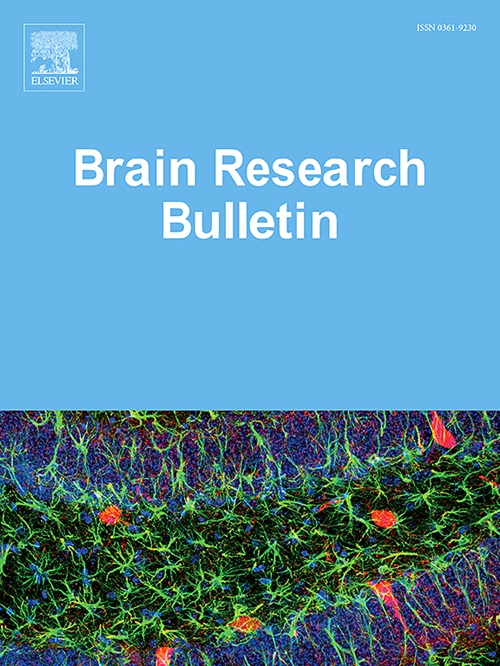雷马唑仑通过 HMGB1-TLR4-NF-κB 通路改善深度低体温循环停止后的术后认知功能障碍
IF 3.7
3区 医学
Q2 NEUROSCIENCES
引用次数: 0
摘要
背景术后认知功能障碍(POCD)是深低温循环骤停(DHCA)的并发症之一。深低温循环骤停(DHCA)术后出现的各种神经功能障碍通常归因于全身炎症反应综合征和脑缺血/再灌注损伤。雷马唑仑是常用的麻醉药物之一,对败血症和脑缺血再灌注损伤等炎症性疾病具有保护作用。方法建立 DHCA 大鼠模型,在心肺旁路(CPB)期间给予梯度剂量的雷马唑仑。大鼠的认知功能通过莫里斯水迷宫进行评估。采用苏木精和TUNEL染色评估海马组织损伤和神经元凋亡。用酶联免疫吸附试验分析炎性细胞因子的浓度。结果适当剂量的雷马唑仑可减少 DHCA 后的组织学损伤、神经元凋亡、小胶质细胞活化和继发性炎症级联,并下调 HMGB1-TLR4-NF-κB 通路的表达,改善 DHCA 大鼠的记忆和学习能力。结论 瑞马唑仑可通过 HMGB1-TLR4-NF-κB 信号通路改善 DHCA 后的 POCD。本文章由计算机程序翻译,如有差异,请以英文原文为准。
Remimazolam ameliorates postoperative cognitive dysfunction after deep hypothermic circulatory arrest through HMGB1-TLR4-NF-κB pathway
Background
Postoperative cognitive dysfunction (POCD) is a complication of deep hypothermic circulatory arrest (DHCA). Various amounts of neurologic dysfunctions have been shown after DHCA, which has often been attributed to systemic inflammatory response syndrome and cerebral ischemia/reperfusion injury. Remimazolam is one of the commonly used anesthetic drugs with protective actions against inflammatory diseases, such as sepsis and cerebral ischemia/reperfusion injury. Here, we determined the protective effect and potential mechanism of action of remimazolam against neuronal damage after DHCA.
Methods
A rat model of DHCA was established, and a gradient dosage of remimazolam was administered during cardiopulmonary bypass (CPB). The cognitive function of rats was evaluated by Morris water maze. Hematoxylin and eosin and TUNEL staining were performed to assess hippocampus tissue injury and neuronal apoptosis. Inflammatory cytokines concentration were analyzed by enzyme-linked immunosorbent assay. The protein expression was analyzed using automated electrophoresis western analysis and immunohistochemical analysis.
Results
The appropriate dosage of remimazolam reduced histologic injury, neuronal apoptosis, microglia activation, and secondary inflammatory cascades, as well as the downregulation of the expression of the HMGB1-TLR4-NF-κB pathway after DHCA, improved the memory and learning abilities in DHCA rats. Further, administration of a TLR4 antagonist TAK-242 had a similar effect to remimazolam, while the TLR4 agonist LPS attenuated the effect of remimazolam.
Conclusions
Remimazolam could ameliorate POCD after DHCA through the HMGB1-TLR4-NF-κB signaling pathway.
求助全文
通过发布文献求助,成功后即可免费获取论文全文。
去求助
来源期刊

Brain Research Bulletin
医学-神经科学
CiteScore
6.90
自引率
2.60%
发文量
253
审稿时长
67 days
期刊介绍:
The Brain Research Bulletin (BRB) aims to publish novel work that advances our knowledge of molecular and cellular mechanisms that underlie neural network properties associated with behavior, cognition and other brain functions during neurodevelopment and in the adult. Although clinical research is out of the Journal''s scope, the BRB also aims to publish translation research that provides insight into biological mechanisms and processes associated with neurodegeneration mechanisms, neurological diseases and neuropsychiatric disorders. The Journal is especially interested in research using novel methodologies, such as optogenetics, multielectrode array recordings and life imaging in wild-type and genetically-modified animal models, with the goal to advance our understanding of how neurons, glia and networks function in vivo.
 求助内容:
求助内容: 应助结果提醒方式:
应助结果提醒方式:


